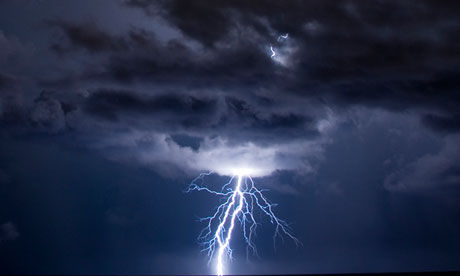
A bolt of lightning strikes a field; 25 miles away, somebody gets a migraine. You wouldn't think the two events could be connected – but a new study, published in the US journal Cephalalgia, is claiming that there is a link between lightning and the appalling headaches that affect eight million people in the UK.
Researchers at the University of Cincinnati College of Medicine, compared data collected from lightning sensors in two US states, Ohio and Missouri, with headache logs kept by 90 migraineurs, those diagnosed with migraine. Their conclusion was startling: the migraineurs were 28% more likely to experience an attack on days when lighting struck within 25 miles of their home.
Assessing the causes of a migraine is always problematic. As a migraineur since my late teens, I'm painfully aware that although many neurologists have useful theories, nobody has conclusively established what a migraine is. What we do know is that migraine is probably related to changes in the levels of serotonin in the bloodstream – and that it's far from a common headache. Migraine is an explosion of pain, usually felt on one side of the face, and often accompanied by sensitivity to light and noise, nausea and visual disturbances, or "aura". Without medication the pain is unbearable: during some of my worst attacks, I've been known to bang my head on the wall.
There is no cure, but we migraineurs are encouraged, like those in the Cincinnati study, to keep diaries, noting when we get an attack, and any recognised trigger factors that might have contributed to it. These triggers, which have been usefully collated by the charity Migraine Action, are innumerable: watching TV, emotional stress, changes in sleep patterns, dehydration, travelling, certain foods, such as cheese, chocolate and red wine – the list goes on. Usually, over time, you'll find that your own personal pattern emerges: combine two or more of these triggers, and you're in the danger zone for an attack.
So where does lightning fit into this? Certain weather conditions are among the trigger factors – from bright sunlight to cold winter winds and thunderstorms. The Cincinnati study is the first, however, to suggest that lightning could be a trigger in itself. Any such study has limitations – there could have been any number of other factors jointly causing the migraineurs' attacks – but its conclusions are worth examining nonetheless.
For Joanna Hamilton-Colclough, director of Migraine Action, the study highlights the importance for migraineurs of considering any links between weather and their attacks. "This is the first time I've heard about lightning being linked to migraine," she says, "but a lot of people do report weather changes, like thunderstorms, as a trigger. Of course you can't control the weather. But you can look at reducing those other factors you can control: such as stress, or getting too little sleep."
I've long suspected a connection between my migraines and thunderstorms, as well as hot, bright weather; but that's nothing compared with Dawn Binks's experience of the links between weather and migraine. A migraineur since the age of 23 – she is now 43 – she gets attacks on between 20 and 23 days a month, meaning that she is unable to work. She has identified weather changes as a key trigger. "Every time the seasons change," she says, "I know that for about 10 days, there'll be hell to pay. Very bright sunlight, strong winds and hot, humid weather are all triggers, too. My migraines dictate the holidays my family can take – I can't go anywhere hot, and travel is another major trigger, so we tend to just go somewhere local."
Exactly how weather can bring on a migraine is unclear. But Dr Andrew Dowson, chairman of Migraine Action's medical advisory board and director of headache services at London's Kings College Hospital, offers a compelling explanation. "People with migraine have brains that are very sensitive to change," he says. "The hypothalamus region of the brain reads these changes, and sets up a series of events in the brain stem. Many people report air pressure as one of these changes. Lightning, as an aspect of stormy weather, is related to changes in air pressure – so it does make sense that there could be a link."
Dr Brendan Davies, a neurologist and trustee with the Migraine Trust, agrees. "It's difficult to single out lightning from a wider cascade of weather changes," he says. "But we know that around a third of migraine patients report weather conditions as a trigger factor – with low pressure as the most common. With lightning, you have areas of low pressure, in conjunction with electromagnetic forces and the release of nitric oxide, which we know to be one of the molecules involved in migraine. That all makes this study very interesting."
Short of setting up a hotline to the Met Office – or, more prosaically, moving to a country where the weather best suits our condition, as Dawn Binks says several sufferers she knows have done – migraineurs can do little to ensure that the climate is kind to them. But a study such as this, shedding further light on the links between weather and migraine, has to be a useful step in understanding a condition that still keeps so many of us in the dark, in every sense.

